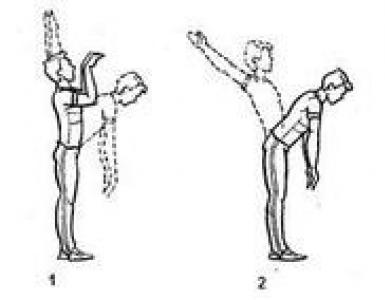Which of the metals has a larger radius of the atom. Sizes of atomic radii of metals
Atomic ions; make sense of the radii of spheres representing these atoms or ions in molecules or crystals. Atomic radii make it possible to approximately estimate the internuclear (interatomic) distances in molecules and crystals.
The electron density of an isolated atom decreases rapidly as the distance to the nucleus increases, so that the radius of the atom could be defined as the radius of the sphere in which the main part (for example, 99%) of the electron density is concentrated. However, to estimate internuclear distances, it turned out to be more convenient to interpret atomic radii differently. This led to the emergence of various definitions and systems of atomic radii.
The covalent radius of an X atom is defined as half the length of a simple chemical bond X — X. Thus, for halogens, covalent radii are calculated from the equilibrium internuclear distance in the X 2 molecule, for sulfur and selenium in the S 8 and Se 8 molecules, for carbon in the diamond crystal. The exception is the hydrogen atom, for which the covalent atomic radius is assumed to be 30 pm, while half the internuclear distance in the H 2 molecule is 37 pm. For compounds with a covalent bond character, as a rule, the additivity principle is fulfilled (the bond length X — Y is approximately equal to the sum of the atomic radii of the atoms X and Y), which makes it possible to predict bond lengths in polyatomic molecules.
Ion radii are defined as quantities whose sum for a pair of ions (for example, X + and Y -) is equal to the shortest internuclear distance in the corresponding ionic crystals. There are several systems of ionic radii; Systems differ in numerical values for individual ions depending on which radius and which ion is taken as the basis for calculating the radii of other ions. For example, according to Pauling, this is the radius of the O 2- ion, assumed to be 140 pm; according to Shannon, the radius of the same ion, taken to be equal to 121 pm. Despite these differences, different systems in calculating internuclear distances in ionic crystals lead to approximately the same results.
Metallic radii are defined as half the shortest distance between atoms in a metal lattice. For metal structures that differ in type of packaging, these radii are different. The proximity of the values of the atomic radii of various metals often serves as an indication of the possibility of the formation of solid solutions by these metals. Additivity of the radii allows predicting the parameters of the crystal lattices of intermetallic compounds.
Van der Waals radii are defined as quantities whose sum is equal to the distance by which two chemically unrelated atoms of different molecules or different groups of atoms of the same molecule can approach. On average, the van der Waals radii are about 80 pm larger than the covalent radii. Van der Waals radii are used to interpret and predict the stability of molecular conformations and the structural ordering of molecules in crystals.
Lit .: Hauscroft K., Constable E. The modern course of general chemistry. M., 2002. T. 1.
BASES OF PHYSICAL CHEMISTRY OF ALLOYS
Lecture notes
Compiled by the Associate Professor of the Department TFiHOM,
ph.D., Associate Professor Chumachenko G.V.
STRUCTURE OF ALLOYS. METAL CHEMICAL PROPERTIES
ELEMENTS
Alloy Is a substance obtained by fusion (possibly sintering, electrolysis, sublimation) of two or more elements.
If in the solid state there is no chemical interaction between the elements and they are not capable of mutual dissolution, then the structure of the alloy is mechanical mixture grains of both components.
Substances that make up the alloy, can enter into chemical interaction, forming chemical compounds, or mutually dissolve in each other, forming solutions. In alloys, the formation of intermediate phases is possible, which are not related either to chemical compounds or to solutions.
The most important factors determining the nature of the interaction of metals with each other and with non-metals are:
The size of the atomic radii of metals;
The position of metals in the series of electronegativity of elements;
Valence and ionization potential of elements.
All these properties depend on the position of the elements in the periodic system. With reference to the interaction of metals, by definition, I.I. Kornilov they are called metal chemical propertiesitems.
To determine the nature of the interaction and the types of chemical bonds arising from this (liquid and solid) and metal compounds, it is necessary to consider the metal chemical properties of the elements only in interconnection, and not separately.
Sizes of atomic radii of metals
Many reactions between metals and metals with metalloids differ from ordinary chemical reactions by their atomic nature, the formation of solutions and compounds in a crystalline state with a characteristic type of metallic and covalent bond between atoms. Therefore, the interatomic distances determined by the atomic radii of the elements are of great importance.
Each atom corresponds to a sphere of action of a certain radius, called atomic radius, which represents the minimum distance by which the centers of the spheres of some atoms approach the surface of the spheres of other atoms.
Atomic radii, like many other properties of elements, have a strict periodic dependence on the atomic number of an element. In fig. 1 presents the values of the atomic radii of elements by groups of elements of the periodic system. In this figure, the elements beryllium, boron and aluminum are located in groups II and III of subgroup B, where they show a greater sequence of changes in the atomic radius than in group A.
Fig. 1. Atomic radii of elements by groups of the periodic system
According to the values of atomic radii, all elements can be divided into three families. One of them covers elements with average values of atomic radii, and the other two extreme families - elements with maximum and minimum values of this property.
When considering fig. 1, the following characteristic features can be noted: the metals of groups I and II of subgroup A with the smallest atomic numbers belonging to the most typical metals have the highest values of atomic radii; the lowest values refer to typical light metalloids (B, C, N, O, H) - elements of the III-VII groups of subgroup B. Heavy metals of the III-V groups of Subgroups B with large atomic numbers (In, Tl, Sn, Pb, Sb, Bi) show an increase in the size of atomic radii with increasing atomic numbers. Metals belonging to the group of transition elements (III-VIII) with an unfilled d-electron shell, as well as metals of groups I and II of subgroup B have average values of atomic radii.
The sequence of changing the atomic radius of elements by groups is to reduce its size as the atomic number of an element of a given group decreases.
The similarity or difference of the atomic radii of elements in connection with other properties of atoms is crucial for the interaction of metals, in particular for the reactions of formation of compounds.
NUCLEAR RADIUS effective characteristics of atoms, allowing an approximate estimate of the interatomic (internuclear) distance in molecules and crystals. According to the concepts of quantum mechanics, atoms do not have clear boundaries, but the probability of finding an electron associated with a given nucleus, at a certain distance from this nucleus, rapidly decreases with increasing distance. Therefore, a certain radius is attributed to the atom, assuming that the vast majority of the electron density (90-98%) lies in the sphere of this radius. A. p. - the values are very small, on the order of 0.1 nm, however, even small differences in their sizes can affect the structure of the crystals built from them, the equilibrium configuration of molecules, etc. Experimental data show that in many respects. In cases where the shortest distance between two atoms is indeed approximately equal to the sum of the corresponding A. p. (the so-called additivity principle A. p.). Depending on the type of bond between the atoms, metallic, ionic, covalent and van der Waals A. are distinguished. R. Metallich. the radius is equal to half the shortest distance between the atoms in the crystal. metal structure. Its value depends on the coordinator. K numbers (the number of the nearest neighbors of an atom in a structure). Most often there are metal structures with K = 12. If we take the value A. p. in such crystals for 1, then A. p. metals with TO, equal to 8, 6 and 4, constitute acc. 0.98, 0.96 and 0.88. The proximity of the values of A. p. different metals is a necessary (albeit insufficient) condition that these metals form solid substitution p-ry. Thus, liquid K and Li (radii of 0.236 and 0.155 nm, respectively) are usually not mixed, and K with Rb and Cs form a continuous series of solid solutions (radii of Rb and Cs, respectively. 0.248 and 0.268 nm). Additivity metallic. A. p. allows to predict crystalline parameters with moderate accuracy. intermetallic lattices. compounds. Ion radii are used for approximate estimates of the shortest internuclear distances in ionic crystals, assuming that these distances are equal to the sum of the corresponding ionic radii of the atoms. There are several. systems of values of ionic radii, differing for individual ions, but leading to approximately the same internuclear distances in ionic crystals. For the first time, ionic radii were determined in the 20s. 20 in. V.M. Goldschmidt, based on refractometric. the values of the radii F - and O 2- equal respectively. 0.133 and 0.132 nm. In the system of L. Pauling, the basis is the value of the O2- ion radius, equal to 0.140 nm, in the common system of N. V. Belov and G. B. Bokiya the radius of the same ion is taken to be 0.136 nm, and in the K. Shannon system -0.121 nm (K = 2). The covalent radius is equal to half the length of a single chemical. XXX bonds, where X is a non-metal atom. For halogen-free covalent A. p. is half the internuclear distance in the X 2 molecule, for S and Se in the X 8, for C in the diamond crystal. Covalent radii of F, Cl, Br, I, S, Se, and C are equal. 0.064, 0.099, 0.114, 0.133, 0.104, 0.117 and 0.077 nm. The covalent radius of hydrogen is assumed to be 0.030 nm, although half the length of the LNC bond in the H 2 molecule is equal to 0.037 nm. Using the additivity rule A. p., Predict bond lengths in polyatomic molecules. For example, the lengths of the CCN, CCFF and CCN1 links should be 0.107, 0.141 and 0.176 nm, respectively, and they are approximately equal to the indicated values in the pl. org. molecules that do not contain multiple carbon-carbon bonds; otherwise, the corresponding internuclear distances are reduced. Van der Waals radii determine the effective sizes of atoms of noble gases. It is also believed that these radii are equal to half the internuclear distance between the closest identical atoms that are not connected to each other. connection, ie, belonging to different molecules, for example. in molecular crystals. The values of van der Waals radii are found, using the A. p. Additivity principle, from the shortest contacts of neighboring molecules in crystals. On average, they are ~ 0.08 nm larger than the covalent radii. Knowledge of van der Waals radii allows one to determine the conformation of molecules and their packing in molecular crystals. Such conformations of molecules are usually energetically favorable, in which the overlap of van der Waals radii of valence unbonded atoms is small. The van der Waals spheres of valencely bound atoms over one molecule overlap. Ext. the contour of the overlapping spheres determines the shape of the molecule. Molecular crystals obey the principle of close packing, according to the Krom of the molecule, modeled by its “van der Waals bordering”, are located, that the “protrusions” of one molecule are included in the “hollows” of the other. Using these ideas, we can interpret crystallographic. data, and in some cases, to predict the structure of molecular crystals. Lit .: Bocky and G. B., Crystal chemistry, 3rd ed., M., 1971, p. 136-41; Pauling L., Po Lin G. P., Chemistry, trans. With English, M., 1978; Modern crystallography, t. 2, M., 1979, p. 67-88. V. G. Dashevsky.













